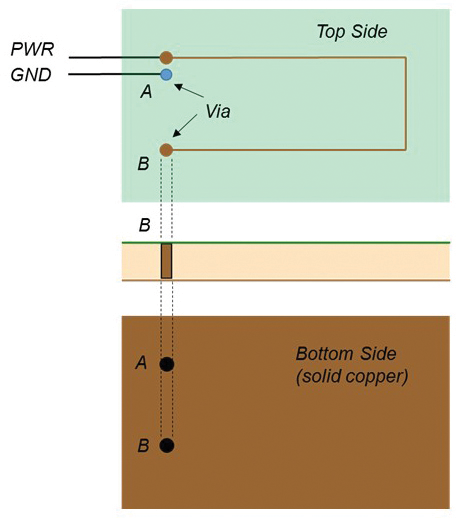Foundations
Consider a two-sided PCB with a single trace on top and full copper ground plane on the bottom, shown in Figure 1. At points A and B, vias connect the top trace to the ground plane [1, 2].

The forward current flows on the top trace as shown in Figure 2.

Upon reaching the point B the current travels through a via to the ground plane and returns to the source. But how does the return current flow back to the source? The return current has a few options: the direct path from B to A or an alternative path underneath the top trace, or a combination of both, as shown in Figure 3.

Current returns to the source through the path of least impedance. Using the lumped-parameter circuit theory we can associate this impedance, Zg, with the ground path and model it as
Zg = Rg + jωLg (1)
where Rg and Lg are the ground path resistance and inductance, respectively.
At low frequencies the ground current will take the path of least resistance, the direct path from B to A (which corresponds to the path of the lowest impedance). This is shown in Figure 4.

At high frequencies the return current will take the path of least inductance, which is directly underneath the trace, because this represents the smallest loop area (smallest inductance). This is shown in Figure 5.

Figure 6 shows the simulation results for a two-sided PCB analyzed in this section.

At low frequencies (1 – 100 kHz) the majority of the return current is through the direct path of least resistance. As the frequency is increased to 500 – 1,000 KHz, the current splits between the two paths. At high frequencies (10 – 100 MHz) the majority of the return current flows underneath the top trace through the path of least inductance.
The just-presented PCB return current path discussion can be directly extended to a coaxial cable configuration shown in Figure 7 [3, 4].

The forward current flows in the center conductor. The return current can either flow through a direct path (low-frequency return path) or the shield (high-frequency return path). In the next section we will show the measurement results of this return current.
The preceding discussion considered the return current flow when the return path was through a solid (uninterrupted) ground plane. Let us now investigate the effect of a discontinuity in the ground plane, as shown in Figure 8.

When the return plane contains a slot or a cutout, the return current flows around it creating a larger current loop area. This is shown in Figure 8. Larger current loop area results in the increase in both the radiation and the loop inductance (both detrimental effects). In the next section we will show the radiation measurement results from this structure.
The clearance holes impede the current flow to a lesser degree. If the holes do not overlap and the return current can flow between them, there is no significant increase in the radiation. In the next section we will verify this with the measurement results.
Verification
Let’s confirm the above conclusions with the measurements. Figure 9 shows the experimental setup used for the (uninterrupted) return current measurements.

The signal from the function generator travels along the center conductor of the coaxial cable, and through the 50 Ω load resistor. The return current has two different paths to return to the source: the direct path over the copper wire or the path through the shield of the coaxial cable. A current probe is placed over the copper wire and a sinusoidal signal is generated by the function generator. The frequency of this signal is varied and current through the copper wire is measured.
Figure 10 shows the measurement results.

As expected, as the frequency increases more current returns through the shield as it provides the lower impedance path than the direct copper wire.
Now let’s look at the effect of the return path discontinuities. The two-sided PCB used for the measurements, [3, 4], is shown in Figure 11.

The forward current flows in the solid copper trace on the top surface and returns on the copper ground plane which contains several discontinuities. The experimental setup is shown in Figure 12.

An H-field probe placed above the trace at several locations measures the radiated field caused by the current flowing along different loops. The larger the loop the larger the emissions. The measurement results shown in Figure 13 verify these conclusions and are consistent with the discussion presented at the end of the previous section.

References
- Henry W. Ott, Electromagnetic Compatibility Engineering, Wiley, 2009.
- Bogdan Adamczyk, Foundations of Electromagnetic Compatibility with Practical Applications, Wiley, 2017.
- Tom Van Doren, Grounding and Shielding of Electronic Systems, EMC course, Las Cruces, NM, 2007.
- Bill Spence and Pete Vander Wel, Designers of the coaxial cable structure and PCB, Gentex Corp, 2008.
